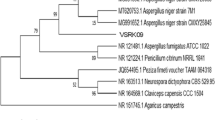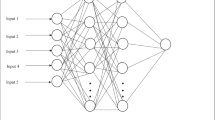Abstract
The hemicellulose content present in corn cobs can help in producing a high amount of xylooligosaccharides (XOS) in an eco-friendly manner. In this work, the XOS was produced from alkali pre-treated corn-cobs having a true yield of 38 ± 1.4% via enzymatic hydrolysis with the help of xylanase from T. lanuginosus VAPS-24. The production process was optimized to achieve a high concentration of XOS using innovative multi-objective optimization through machine learning modeling and finding out the most suitable parameters where xylobiose production is higher than xylose. The Multi-objective connected neural networks (MOCNN) model with tangent sigmoid activation function yielded a correlation coefficient of 96.51%; there were six optimal sets where xylobiose concentration was higher than xylose. The best-optimized conditions yielded 3.03 mg/ml of xylobiose and 1.31 mg/ml of xylose. Therefore, this novel approach of machine learning can target the increasing demand for xylooligosaccharides in the growing industrial market of prebiotics.






Similar content being viewed by others
References
Tlais AZA, Fiorino GM, Polo A et al (2020) High-value compounds in fruit, vegetable and cereal byproducts: an overview of potential sustainable reuse and exploitation. Molecules 25:2987. https://doi.org/10.3390/molecules25132987
Ávila PF, Martins M, Goldbeck R (2020) Enzymatic production of xylooligosaccharides from alkali-solubilized arabinoxylan from sugarcane straw and coffee husk. BioEnergy Res. https://doi.org/10.1007/s12155-020-10188-7
Álvarez C, González A, Alonso JL et al (2020) Xylooligosaccharides from steam-exploded barley straw: structural features and assessment of bifidogenic properties. Food Bioprod Process 124:131–142. https://doi.org/10.1016/j.fbp.2020.08.014
Kumar V, Bahuguna A, Ramalingam S, Kim M (2021) Developing a sustainable bioprocess for the cleaner production of xylooligosaccharides: An approach towards lignocellulosic waste management. J Clean Prod. https://doi.org/10.1016/j.jclepro.2021.128332
Kucharska K, Rybarczyk P, Hołowacz I et al (2020) Influence of alkaline and oxidative pre-treatment of waste corn cobs on biohydrogen generation efficiency via dark fermentation. Biomass Bioenerg 141:105691. https://doi.org/10.1016/j.biombioe.2020.105691
Guo J, Cao R, Huang K, Xu Y (2020) Comparison of selective acidolysis of xylan and enzymatic hydrolysability of cellulose in various lignocellulosic materials by a novel xylonic acid catalysis method. Bioresour Technol 304:122943. https://doi.org/10.1016/j.biortech.2020.122943
Guo J, Huang K, Zhang S, Xu Y (2020) Optimization of selective acidolysis pre-treatment for the valorization of wheat straw by a combined chemical and enzymatic process. J Chem Technol Biotechnol 95:694–701. https://doi.org/10.1002/jctb.6251
Azzouz Z, Bettache A, Djinni I et al (2020) Biotechnological production and statistical optimization of fungal xylanase by bioconversion of the lignocellulosic biomass residues in solid-state fermentation. Biomass Convers Biorefinery. https://doi.org/10.1007/s13399-020-01018-z
Shukla V, Phulara SC (2020) Impact of culture condition modulation on the high-yield, high-specificity and cost-effective production of terpenoids from microbial sources: a review. Appl Environ Microbiol. https://doi.org/10.1128/AEM.02369-20
Skariyachan S, Khangwal I, Niranjan V et al (2020) Deciphering effectual binding potential of xylo-substrates towards xylose isomerase and xylokinase through molecular docking and molecular dynamic simulation. J Biomol Struct Dyn. https://doi.org/10.1080/07391102.2020.1772882
Aghashahi A (2020) Oligosaccharides production and purification from barley bran using sequential supercritical CO2 extraction, subcritical water hydrolysis and membrane filtration. Dissertation, University of Alberta. https://doi.org/10.7939/r3-8fb7-2w30
Pinales-Márquez CD, Rodríguez-Jasso RM, Araújo RG et al (2021) Circular bioeconomy and integrated biorefinery in the production of xylooligosaccharides from lignocellulosic biomass: a review. Ind Crops Prod 162:113274. https://doi.org/10.1016/j.tifs.2021.02.047
Mathibe BN, Malgas S, Radosavljevic L et al (2020) Lignocellulosic pretreatment-mediated phenolic by-products generation and their effect on the inhibition of an endo-1, 4-β-xylanase from thermomyces lanuginosus VAPS-24. 3 Biotech 10:1–11. https://doi.org/10.1007/s13205-020-02343-w
Khangwal I, Nath S, Kango N, Shukla P (2020) Endo-xylanase induced xylooligosaccharide production from corn cobs, its structural features, and concentration-dependent antioxidant activities. Biomass Convers Biorefinery. https://doi.org/10.1007/s13399-020-00997-3
Din NAS, Lim SJ, Maskat MY, Zaini NAM (2020) Bioconversion of coconut husk fibre through biorefinery process of alkaline pre-treatment and enzymatic hydrolysis. Biomass Convers Biorefinery. https://doi.org/10.1007/s13399-020-00895-8
Jnawali P, Kumar V, Tanwar B et al (2018) Enzymatic production of xylooligosaccharides from brown coconut husk treated with sodium hydroxide. Waste Biomass Valoriz 9:1757–1766. https://doi.org/10.1007/s12649-017-9963-4
Kumar V, Chhabra D, Shukla P (2017) Xylanase production from Thermomyces lanuginosus VAPS-24 using low cost agro-industrial residues via hybrid optimization tools and its potential use for saccharification. Bioresour Technol 243:1009–1019. https://doi.org/10.1016/j.biortech.2017.07.094
Bailey MJ, Biely P, Poutanen K (1992) Interlaboratory testing of methods for assay of xylanase activity. J Biotechnol 23:257–270. https://doi.org/10.1016/0168-1656(92)90074-J
Miller GL (1959) Use of dinitrosalicylic acid reagent for determination of reducing sugar. Anal Chem 31:426–428. https://doi.org/10.1021/ac60147a030
Chhabra D, Deswal S (2020) Optimization of significant factors for improving compressive strength of ABS in fused deposition modeling by using GA & RSM. In: IOP conference series: materials science and engineering. IOP Publishing, p 12007. https://doi.org/10.1088/1757-899X/748/1/012007
Deshwal S, Kumar A, Chhabra D (2020) Exercising hybrid statistical tools GA-RSM, GA-ANN and GA-ANFIS to optimize FDM process parameters for tensile strength improvement. CIRP J Manuf Sci Technol. https://doi.org/10.1016/j.cirpj.2020.05.009
McCleary BV, McGeough P (2015) A comparison of polysaccharide substrates and reducing sugar methods for the measurement of endo-1,4-β-Xylanase. Appl Biochem Biotechnol 177:1152–1163. https://doi.org/10.1007/s12010-015-1803-z
Palaniappan A, Antony U, Emmambux MN (2021) Current status of xylooligosaccharides: production, characterization, health benefits and food application. Trends Food Sci Technol. https://doi.org/10.1016/j.tifs.2021.02.047
Hesam F, Tarzi BG, Honarvar M, Jahadi M (2020) Valorization of sugarcane bagasse to high value-added xylooligosaccharides and evaluation of their prebiotic function in a synbiotic pomegranate juice. Biomass Convers Biorefinery. https://doi.org/10.1007/s13399-020-01095-0
Hesam F, Tarzi BG, Honarvar M, Jahadi M (2020) Pistachio (Pistacia vera) shell as a new candidate for enzymatic production of xylooligosaccharides. J Food Meas Charact. https://doi.org/10.1007/s11694-020-00594-y
Neto FSPP, Roldán IUM, Galán JPM et al (2020) Model-based optimization of xylooligosaccharides production by hydrothermal pre-treatment of Eucalyptus by-product. Ind Crops Prod 154:112707. https://doi.org/10.1016/j.indcrop.2020.112707
Acknowledgements
PS acknowledges the support from the Department of Biotechnology, Government of India (Grant No. BT/PR27437/BCE/8/1433/2018). PS also acknowledges the Lab Infrastructure grant by BHU, Varanasi (F (C) /XVIII-Spl.Fund/Misc/Infrastructure/Instt.Sc/2019-2020/10290 and BTISNET- Sub-Distributed Information Centre, funded by DBT, Govt. of India at the School of Biotechnology, Banaras Hindu University, and Varanasi, India. IK acknowledges the support of the University Research Scholarship by M.D. University, Rohtak, and India No. R&S/R-15/19/1868.
Author information
Authors and Affiliations
Contributions
IK prepared the original draft of the manuscript and analyzed data and PS conceptualized the experiments and edited the final draft and supervised the study. DC contributed in software support and validation of data.
Corresponding author
Ethics declarations
Conflict of interest
The authors declare no conflict of interest.
Ethical Statement
This manuscript does not contain any studies with human or animal participants performed by any of the authors.
Consent for Publication
This research paper does not contain any individual’s personal data in any form.
Additional information
Publisher's Note
Springer Nature remains neutral with regard to jurisdictional claims in published maps and institutional affiliations.
Rights and permissions
About this article
Cite this article
Khangwal, I., Chhabra, D. & Shukla, P. Multi-Objective Optimization Through Machine Learning Modeling for Production of Xylooligosaccharides from Alkali-Pretreated Corn-Cob Xylan Via Enzymatic Hydrolysis. Indian J Microbiol 61, 458–466 (2021). https://doi.org/10.1007/s12088-021-00970-2
Received:
Accepted:
Published:
Issue Date:
DOI: https://doi.org/10.1007/s12088-021-00970-2




